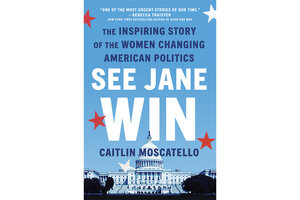‘See Jane Win’: A riveting political deconstruction of 2018
Caitlin Moscatello’s “See Jane Win” dives deep into the triumphs and pitfalls encountered by novice women politicians in the 2018 elections.

“See Jane Win: The Inspiring Story of the Women Changing American Politics” by Caitlin Moscatello, Dutton, 336 pp.
Courtesy of Penguin Random House
By any measure, the 2018 elections were historic: A record 117 women were elected to Congress, including the first two female Muslim representatives; almost 1,900 women (another record) were elected to state legislatures, nine to state governorships, and countless to local office. The New York Times declared 2018 the “Year of the Woman.”
They were largely reacting to the election of President Donald Trump, but other factors played a role. Hillary Clinton’s defeat, as well as the Republicans’ attempt to repeal the Affordable Care Act and threat to overturn Roe v. Wade also propelled women into action. If the press and pundits talked endlessly about the tendency of women to devalue their qualifications and underestimate their abilities – known as “imposter syndrome” and “the confidence gap” – then this group of women were going to prove them wrong.
In “See Jane Win: The Inspiring Story of the Women Changing American Politics,” award-winning journalist Caitlin Moscatello examines the resulting wave of first-time women candidates, focusing on four in particular. Former CIA agent Abigail Spanberger, a mother of three, decided to run for the House of Representatives against a conservative incumbent in a district that hadn’t elected a Democrat since 1971. London Lamar was a 26-year-old African American reproductive rights activist running for the Tennessee state legislature in defiance of local Democratic politicians who considered her too young. Catalina Cruz, an immigration lawyer who had grown up undocumented, set her sights on a seat in the New York State Assembly. And Anna Eskamani, an Iranian-American political activist and Planned Parenthood employee in Orlando, Florida, embarked on an unabashedly liberal campaign for the Florida House of Representatives in a centrist district.
Moscatello’s accounts of each campaign vividly illustrate how much harder most women have it than men when they run for office. Spanberger had to devise interview strategies to squash any impression that she was neglecting her children – something it’s unlikely a father would have had to worry about. Eskamani received an email falsely accusing her of having performed in an adult film, and threatening to out her if she didn’t end her campaign. And for women of color the challenges of racism ranged from the cosmetic to the potentially life-threatening. When Ayanna Pressley was campaigning for Congress in Massachusetts, she was encouraged to change her hair because her preferred style (Senegalese twists) wasn’t “polished enough.” When Sheila Stubbs, an African-American candidate for the Wisconsin State Assembly, was campaigning door-to-door with her mother and eight-year-old daughter, someone called 911 to report a suspected drug dealer in the neighborhood.
Women must also walk a fine line that would be unheard of for most male candidates. If a woman emphasizes her qualifications, she’s often perceived as arrogant. She must appear confident, compassionate, and approachable. Moscatello’s account of how these women pulled off this balancing act makes “See Jane Run” a primer on campaigning.
For example, Catalina Cruz had enjoyed a notable career in public service before she ran for an assembly seat. But to show a more personal side, she was advised to ask her mother to write a letter addressed to the public about how proud she was of her daughter. It was a sentimental tactic, but it worked: People called Cruz’s campaign office to say the letter from her mother was why they were voting for her.
Then there’s money. Women candidates often don’t have access to potential donors in highly lucrative fields, so fundraising requires them to ask more people for small amounts, or work harder to leverage their existing networks. The Democratic Congressional Campaign Committee doesn’t help matters for novice candidates: They allocate money to the campaigns they think will win and they measure the likelihood of winning by previous success in fundraising. None of this makes fundraising impossible, just more difficult for women. Ironically, small donations can ultimately be more valuable. As one political consultant put it, “a small donor is not just a donor, they are a voter, and they will likely not go to the polls alone.”
It’s a tribute to Moscatello’s skill as a writer that she can make topics like fundraising and myriad other facets of campaigning interesting. And the story she tells is a much needed on-the-ground account of the obstacles women entering politics face, and the victories that are possible. Readers of “See Jane Win” will be fascinated, enlightened, outraged and, ultimately, inspired.

